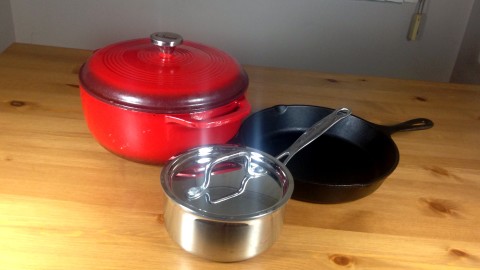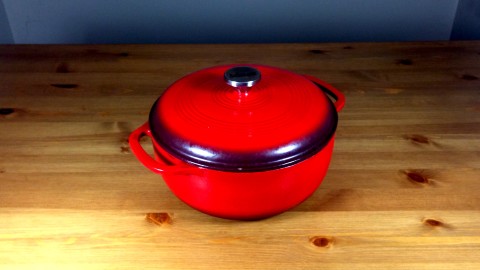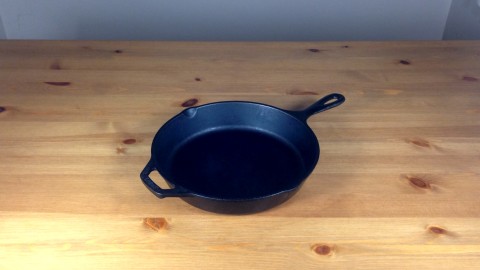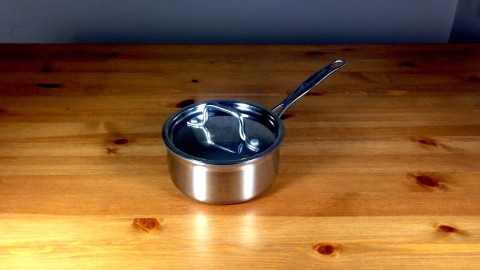
Think you need eleventy bajillion pots and pans in your house to make a meal?
Hardly.
For most people, three pots and pans are all you need if you’re learning to cook, and will allow you to prepare 95% of the meals you’ll ever need.
Last time we took a look at what it takes to stock your kitchen, and how few things you really need.
Today we’ll take a look at the backbone of your kitchen: cookware.
As we’ll see, you only need a total of three pots and pans for the vast majority of your cooking needs.
A Dutch Oven

Without a doubt, the most important piece of cookware you can have is a big-ass pot, aka a Dutch oven.
Why?
Not only can a pot serve as a pan in a pinch, frying up meat and veggies, but the things that you make in a pot–soups, stews, braises–are exactly the types of meals you should be making if you’re first learning how to cook.
For the most part, you’ll be using this pot for low-and-slow cooking, so quality isn’t as big a concern if you’re strapped for cash.
The most important thing you’re looking for here is a size of between 6–8 quarts (6–8 L). Smaller and you’ll have a tough time making more than a couple servings, bigger and you’ll make more food than you can eat in a week.
If you got a set of cookware from Target or Ikea when you first started living on your own, you probably have one of these already.
But if you’re in the market for a big-ass pot, I suggest you skip the nonstick ones and go for the mack daddy of them all: the enameled cast-iron Dutch oven.
Dutch ovens (no, not that kind) are made of iron, which makes them hold heat really well and evenly.
The enameled coating allows you to slow cook acidic ingredients like tomatoes, and makes cleanup much easier as well.
- Top of the Line–The Le Creuset French oven (ooh la la!) is the highest-quality big-ass pot on the market, but at $300 or more, this is really only an option for the serious gangstas.
- Best Value–The Lodge Dutch oven is nearly as good as the Le Creuset, but waaaaaaay cheaper. It’s the one I use.
- Good Enough–The Oster Telford Dutch oven is about as cheap as they get. Should do the trick as long as you don’t put it in an oven above 350°F.
A Skillet

A pan is the yang to the pot’s yin.
Where the pot is great for slow-cooking meats and veggies over low heat for long periods of time, melding all the flavors together, the pan is great for giving short blasts of heat and bringing out new flavors altogether.
Whether you’re frying onions and peppers or searing a pork chop, a pan is an essential piece of cookware in any cook’s arsenal.
The most important consideration here is size. You don’t want one of those dinky pans, but rather something in the 10“–12” (25–30 cm) range.
Again, you probably have something like this from that el cheapo cookware set, but this is one time when I suggest that no matter what, you should upgrade your pan and buy a cast-iron skillet.
Simply put, nothing sears like a skillet. Like a Dutch oven, a cast-iron skillet holds a tremendous amount of heat.
The chemical reactions of caramelization and the Maillard reaction are just way too difficult to pull off without a cast-iron skillet, and these are just the types of easy tricks that will allow you to become a kitchen hacking master.
Oh, and there’s another reason. Cast-iron skillets are ridiculously cheap.
I use (and recommend) the 10″ (25 cm) Lodge cast-iron skillet, and you can find it for about $20.
- Top of the Line–For the truly geeky, you may like to know that the best cast-iron skillets were made by companies that have long gone out of business. Fortunately, since they last forever, you can still find quality Griswold or Wagner cast iron skillets on eBay. Look for size 8–10. Happy hunting!
- Best Value–Lodge’s 10″ cast-iron skillet is the pan I use. And since it’s so cheap and gives a much better sear than nonstick ever will, I highly recommend you pick one up.
- Good Enough–None. Most new nonstick skillets cost the same as a Lodge cast-iron skillet. Get that one instead.
A Saucepan

The big-ass pot and pan will do most of the heavy lifting in your kitchen, but I’d still suggest you get a little pot to play a backup role.
You’ll use this mostly for boiling smaller amounts of veggies, beans, and grains at first, but as you level up your kitchen skills you’ll find it’s great for more than just that.
Making sauces is what a saucepan was born to do, baby! And since I like to make stock in bulk and freeze it, a small pot is great for melting small amounts at a time.
Quality is even less important for a saucepan than with a big-ass pot or pan, so your old el cheapo saucepan will do just fine here.
But, if you’d like to get something that will cook more evenly and last for decades, you’ll want something made of stainless steel with a solid aluminum core.
Something in the ~1.5 quart (1.5 L) range will give you the most flexibility. And you’re gonna want a lid.
- Top of the Line–All Clad’s 1.5 quart saucepan is the best on the market, but might be a little pricey.
- Best Value–Cuisinart’s MultiClad Pro 1.5 quart saucepan is nearly as good, but much cheaper. It’s the one I use.
- Good Enough–Cuisinart makes a lower-level Chef’s Classic 1-1/2 quart saucepan.
If you are worried you don’t have enough cookware, go through the list above and buy one of each of the three listed pieces. For 95% of your needs, it’s all that’s necessary.
In the next article, we’ll go over the necessary knife and accessories. (Spoiler alert: you should never buy a full knife set.)
 I'm a science geek, food lover, and wannabe surfer.
I'm a science geek, food lover, and wannabe surfer.
Comments on this entry are closed.